The lab of Luxury
Are the growing number of branded high-end eyewear shops opening worldwide a good marketing tool or competition from within?
By Erinn Morgan
Photography by Peter Baker
Tokyo. Dubai. Hong Kong. Taiwan. New York. These global capitals are the home to relatively new branded optical shops that have been opened by high-end frame manufacturers.
French frame maker Alain Mikli, for example, has a network of 25 stores around the world, from Hong Kong in the Harbour City shopping center to Rodeo Drive in Beverly Hills. Further expansion is planned and Mikli has hired a retail director to oversee this end of the business.
“I will roll out around 15 shops each year in order to rapidly arrive at a global portfolio of 70 retail locations,” says Mikli retail director Jill Blumenfeld who has been with the company for nearly two years. “We will concentrate on North America and China, plus will pursue good opportunities in Europe and the Middle East as well.”
While some ECPs are crying foul as they see more competition opening up, most of these high-end retailers position their new boutiques as a modern marketing tool that is beneficial to the brand—and its customers.
“I think the reason this is happening in our industry is that companies now want to create some branding visibility,” says Allessandro Lanaro, president and CEO of Modo Eyewear, which has two branded optical shops in New York City, including one for its earth-friendly ECO line.“Clearly, this has been done properly in the fashion industry and it is translating into better business for everybody. More customers are asking for brands today, even in optical. The goal here is to help the ECP with a branding story and to help them create a better demand for the brand.”
With an eye to nurturing their business with ECPs, most of these eyewear companies are careful to point out that their retail initiatives are not designed to grab business away from their accounts.
“Our business is to design and develop frames, not to be a retailer,” says Henrik Orgreen, founder of Orgreen Eyewear, which has one flagship store in Copenhagen. “Therefore, we do not have any plans for opening new shops.”
Adds Modo's Lanaro, “We are not getting into retail. We are seeing this as a product development lab where we can also create some branding.”
REASONS FOR BEING
Branding is the main reason most eyewear companies have chosen to go the retail route. In today's competitive marketplace, some say this marketing move is a necessity.

“All luxury brands, large and small, must have at least one retail location in order to help consumers and other retailers understand what the brand is all about,” says Sheila Vance, CEO and designer for Sama eyewear. “No one is in a better position to convey a brand's essence than the brand itself.”
At Mykita, CEO and creative director Moritz Krueger says that their six retail shops are the ideal symbiosis between brand building and business development. “Having our own retail shops allows us to create and show our unique brand architecture and to express our brand philosophy ‘at home' and directly from us to the customer,” he says.
“The Robert Marc stores create a distinctive and memorable brand experience by combining our marketing, merchandising, and client service programs to deliver a unique personality to the customer experience. Our stores reflect the true essence of the brand—the perfect combination of past and future, featuring an exciting mix of exquisite materials, vintage and modern furnishings, and sophisticated luxury details,” says Robert Marc, designer/owner of seven shops.
Adds Orgreen, “We wanted to have an opportunity to show our entire collection and present it the way we think is best. This is also a forum for our other customers to see how we work with the frames as well as how we design our shop.”
“Selling a product is not just about putting it on the shelf. It is also about presenting it in the right environment, and that is partly why we have invested in retail that reflects the way we would like our eyewear sold when it is sold by other opticians,” says Kirk Originals's Jason Kirk.
He notes, “This is by no means a criticism of the traditional optician or any of our contemporaries. But we hope that by putting our money where our mouth is, we will stimulate other opticians to reflect on their retail environment. It is one of the clearest ways for independents to differentiate themselves from the mainstream chains and an important argument against the online competition.”
Most manufacturers dipping into retail also say it is a real boon to product development. “Our Modo shop is a lab for us,” says Lanaro. “It gives us great input into what customers are looking for in a hip market. The benefits from this are incredible, including the fact that it's given us a way to anticipate trends.”
The research and development benefits are so tangible that Modo puts its two stores into the company's product development budget.
THE MERCHANDISE MIX
Displaying the breadth and depth of their proprietary collections is the merchandising onus for most frame makers delving into the retail world. A few, however, are adding onto this philosophy.
“If we realize that a shop isn't covering the portfolio of customer needs,we add other brands,” says Mykita's Krueger. “Right now, four of our six shops only sell Mykita glasses.”
Some of these luxury shops sell contact lenses, but all offer premium lens options to their customers. Mykita has also recently integrated the Zeiss “Relaxed Vision Center” into its shops. This lab is equipped with instruments from Zeiss.
At Orgreen's boutique, five optical brands and seven sunglass brands are stocked with the full Orgreen collection. “If you only carry your own line, then it will become too boring,” says Orgreen, who notes the store will also soon sell the work of local artists on exhibit. EB
DESIGN GALLERY
Designing their dreams, many of the companies launching luxury stores created their own store designs in-house with the help of architects and other designers. Alain Mikli, for example, employed the assistance of the internationally renowned designer Philippe Starck.
With such passion behind their projects, these fledgling retailers broke the optical mold with incredibly modern, sophisticated, and whimsical store designs. For instance, Mykita rounded up a vintage collection of out-of-service, rolling SwissAir flight attendant trolleys to house their frames.
In addition, the frame-maker/retailer created an eye-popping, backlit Mykita Wall that covers the entire right-hand side of the 4.5-meter tall white sales area and highlights the glasses. “It is comprised of an assembly of perforated metal angle beads that are normally used to support heavy-duty shelving,” says Mykita's creative director, Moritz Krueger. “Individual little shelf elements can be attached at any position desired along the wall, thus providing each frame with its own stage. Additional spotlights provide the individual frame with the necessary light.”
“The adjectives that we apply to Kirk Originals and the people who wear our glasses were applied in the brief of our shop design: independent, irreverent, creative, expressive … you get the idea,” Kirk says.
“Our store, designed by Campaign Design, breaks with tradition. We made a list of design features usually associated with optics and said that we did not want to see any of them in our store. No white, no shelves, no contact lens solutions on display. But at the same time, we did not want to belittle or disrespect the tradition and medical importance of other opticians; simply to express that there is a different way,” Kirk adds.


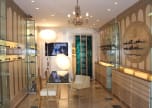
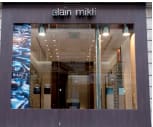
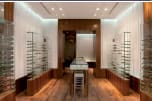


|
Top to bottom: Kirk Original's shop in London shows how the company's original designs can also be originally displayed. Sama's California location's opulence reflects the brand's aesthetic; Alain Mikli's shops in Paris and New York are a few of what is expected to be a collection of 71 shops located around the world to promote the brand's identity in the global luxury market |
Retail director Jill Blumenfeld says Alain Mikli shops regularly change and update in-store displays. And while these boutiques exist, in part, to show off the brands' entire collection, Sama's Sheila Vance says that displaying a limited number of products makes a luxury retail setting feel special.
“We display only the season's key styles and colors and keep the majority of our merchandise in elegant drawers only a fingertip away,” she says. “Luxury merchandising should be a curated experience designed to help the store's expert stylist understand and respond to the customer's exact needs.”
With unique retail concepts housed in eye-catching shop designs, it's no wonder that many of the new luxury retail stores are receiving ample coverage from the media. “Our shops are often mentioned in the press,” says Mykita's Krueger. “We don't really advertise the shops, as word-of-mouth is working very well for us.”
A rundown of high-end frame company's retail locations will run this month at EyecareBusiness.com.
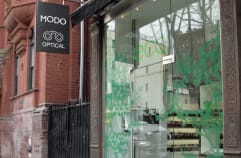

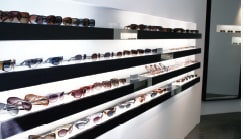
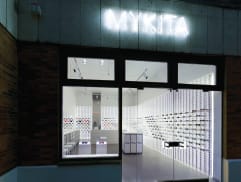
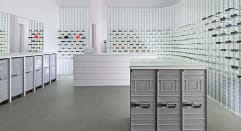

|
Top to bottom: Modo's Eco shop in New York City's Greenwich Village focuses on the company's green initiative eyewear and serves as a retail lab for product development; Mykita's location in Berlin (shown) is one of the company's shops. They have also opened other stores in Japan, Mexico, France, Austria, and Switzerland that feature their own eyewear as well as cosmetic lines. With one location in its home town of Copenhagen, Orgreen shows its products in a retail setting |
| ABOUT FACE |
|---|
| Adding a whole new dimension to its merchandise mix, high-end frame maker Mykita is moving into the cosmetics business. Recently launched as a pilot project in its branded optical shop in Berlin, Mykita MyFace adds selected skincare and makeup products into the assortment here. “Our staff will provide a personal consultation service—from the right specs to facial care,” says CEO and creative director Moritz Krueger. The Mykita Berlin store carries Susanne Kaufmann's organic care products, which are manufactured in a small workshop in Austria in accordance with the highest ecological principles. “Reflecting the philosophy and practice of Mykita, these items are made by hand and incorporate only the best active ingredients,” says Krueger. Mykita also has a long history of working together with Berlin-based makeup label uslu airlines, which is also stocked in the store. Says Krueger, “In addition to the collaboration that produced the Bob & Eve aviator frames duo, our two companies are linked by a common idea—a unification of forms and colors to underline individuality.” |



